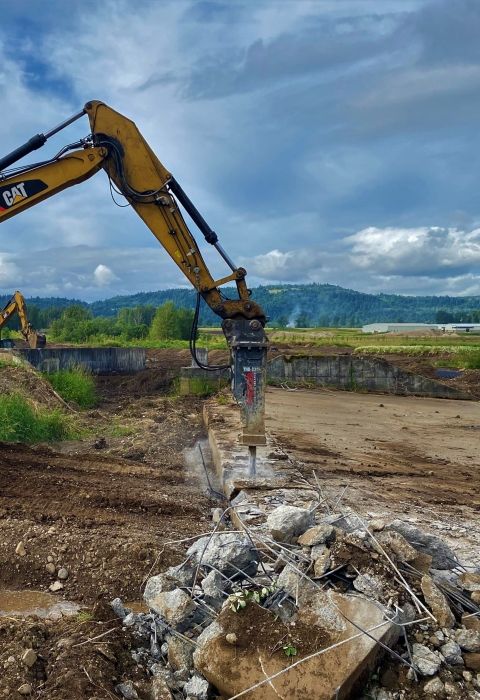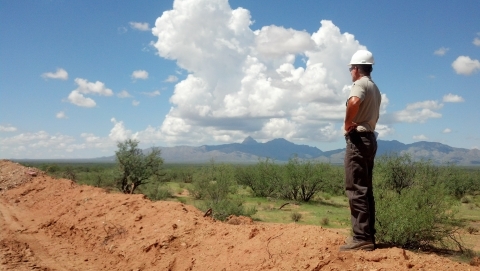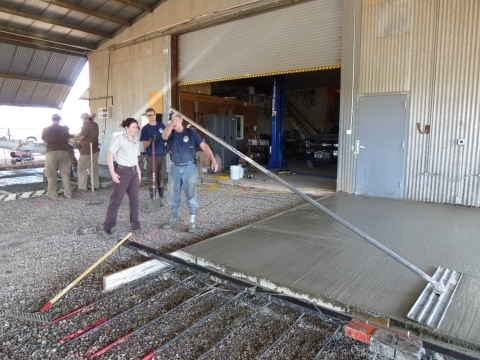I drove up to the unit, a sea of flowering wapato, and saw a sole backhoe working on what seemed to be an island. I walked up a small two-track road approaching the equipment, bright in the hot August sun, and was taken aback by watching it move in a way I had never seen before. The bucket moved side to side, like a hand moving in a pool of water. Teeth tucked under, the back of the bucket skimmed the surface of a gravel pile, sliding each small rock into just the right spot until the site was a smooth sheet. A new hunt blind, chained and sitting to the side, was lifted and lowered onto the leveled bed. Again, like a delicate and precise dance, the bucket gently nudged the sides of the blind, with the care of a mother doe to her day-old fawn. The blind settled into its new location before the door to the cab opened and Chadd hopped out to check his levels.
Chadd Smith is a heavy equipment operator and part of our team at the Ridgefield National Wildlife Refuge Complex. Spending his past years transforming wetlands for endangered species in Hawaiʻi, he has a habitat vision like the anatomical transparency pages in a vintage medical book, with each clear sheet you lift, one less organ is revealed until you get down to the core of the body. Pleading for just a few plots to try his hand at restoring a site using “the perfect equipment for the job,” Chadd is a different kind of habitat restoration expert. When he looks at the landscape, he can see each invasive species invasive species
An invasive species is any plant or animal that has spread or been introduced into a new area where they are, or could, cause harm to the environment, economy, or human, animal, or plant health. Their unwelcome presence can destroy ecosystems and cost millions of dollars.
Learn more about invasive species lifted, edges contoured, native food plants emerging and wildlife abound. The true spine of what the site should be.
On national wildlife refuges, the team consists of experts in visitor experiences, biological management of plants and wildlife, and physical land and facilities management. Many years ago, I was an Assistant Refuge Manger. I was in my 20s and suddenly supervising the visitor services, biology and maintenance programs. At least thirty years my senior, the maintenance wage grade team just knew their stuff. They had worked on the refuge as ranch hands long before the Service had bought the land and protected it as a refuge. They spoke to this land and it spoke back.
Jeff Enlow was the Equipment Operator there. He and his brother had known that soil since before I was born, and now my job was to supervise them…yeah. Without getting too squishy with these veterans of war and life, I let them know, “I can’t tell you how to do your job. I am here to help you do it. You are the experts. I might bring challenges we need to tackle but I’m going to look to you to tell me what we can do about it.” From that point on we had respect. They taught me how to pour concrete, grade roads with the techniques “specific for the desert,” how to change old door handles, repair water catchments and really, whatever else they had going on that day. I taught them that I could organize work, knock out their data calls, and get the supplies they needed to actively manage and restore habitat for fish, wildlife, plants – and people.
Today, deep in the wapato, I saw that same skillset in Chadd. He just knew his stuff. He knew his equipment and he knew what it could accomplish. More than that, I could see he also spoke to the land. A few weeks ago, our refuge biologist, assistant manager and I were standing at the edge of a pond. A deep bowl, too steep for a northwestern pond turtle to easily navigate. Re-sloping was always on the horizon but with limited capacity, remained a bowl. Dense grass and vertical obstacles were no help to turtles cooling in the summer water, who would later need to find shelter in the winter hillside.
As we spoke, looking out at the site, Chadd crouched deep in the grass and surveyed the perimeter in silence. We were talking about options, but he was secretly peeling back the pages of the medical book and having his own conversation with the core, the land. “We can grind out this vegetation and then I can come in and gently pull back this slope making a smooth incline. I’ll avoid these areas where older underground nests may be and use a weed-whacker to open it up until we know for sure. I can see these swales where that water traditionally came in and where it should be…” and on he went. Not only was he pulling back the pages, but he was painting new ones. He outlined what each slope would look like for the next three years and what treatment would be needed per season.
He plucked small pieces of grass as he spoke and broke them into smaller pieces, scratching his beard before scanning again. We were all in agreement that his method sounded positive and trusted him to take the reins. He did. What he painted in words, were painted on the landscape the next week. Smooth slopes, open ground, and healthy plants around the water’s edge framed the basking turtles enjoying their last month of summer. Perhaps they saw us standing there, on the horizon of their winter homes and perhaps they watched as Chadd skimmed the surface to a smooth sheet, gently nudging it forward, like a doe to her fawn.
*Author’s note: Wage grade professionals and others working in or directly supporting maintenance programs in national wildlife refuges, fish hatcheries, and endangered species offices include equipment operators, maintenance workers, tractor operators, animal caretakers, mechanics, boat operators, and others. There are also many other career opportunities on national wildlife refuges and with the U.S. Fish and Wildlife Service. A career with us might also be for you if you’re knowledgeable about public land management, information technology, real estate, engineering, finance, communications, cartography, budgeting, refuge law enforcement or wildlife inspection and wildlife criminal investigation, public policy and more. Click here to learn more about careers and internships.







